Organisation Theory and Practice: Analysis of Marks and Spencer
VerifiedAdded on 2023/06/18
|14
|4298
|63
AI Summary
This report analyses the managerial style, culture, leadership style, power and conflicts, and motivational strategies used by Marks and Spencer to enhance organisational effectiveness. It includes the principles and functions of management, organisational structure, Pondy's theory of conflicts, and Maslow's need hierarchy theory. The report provides recommendations to increase organisational performance.
Contribute Materials
Your contribution can guide someone’s learning journey. Share your
documents today.
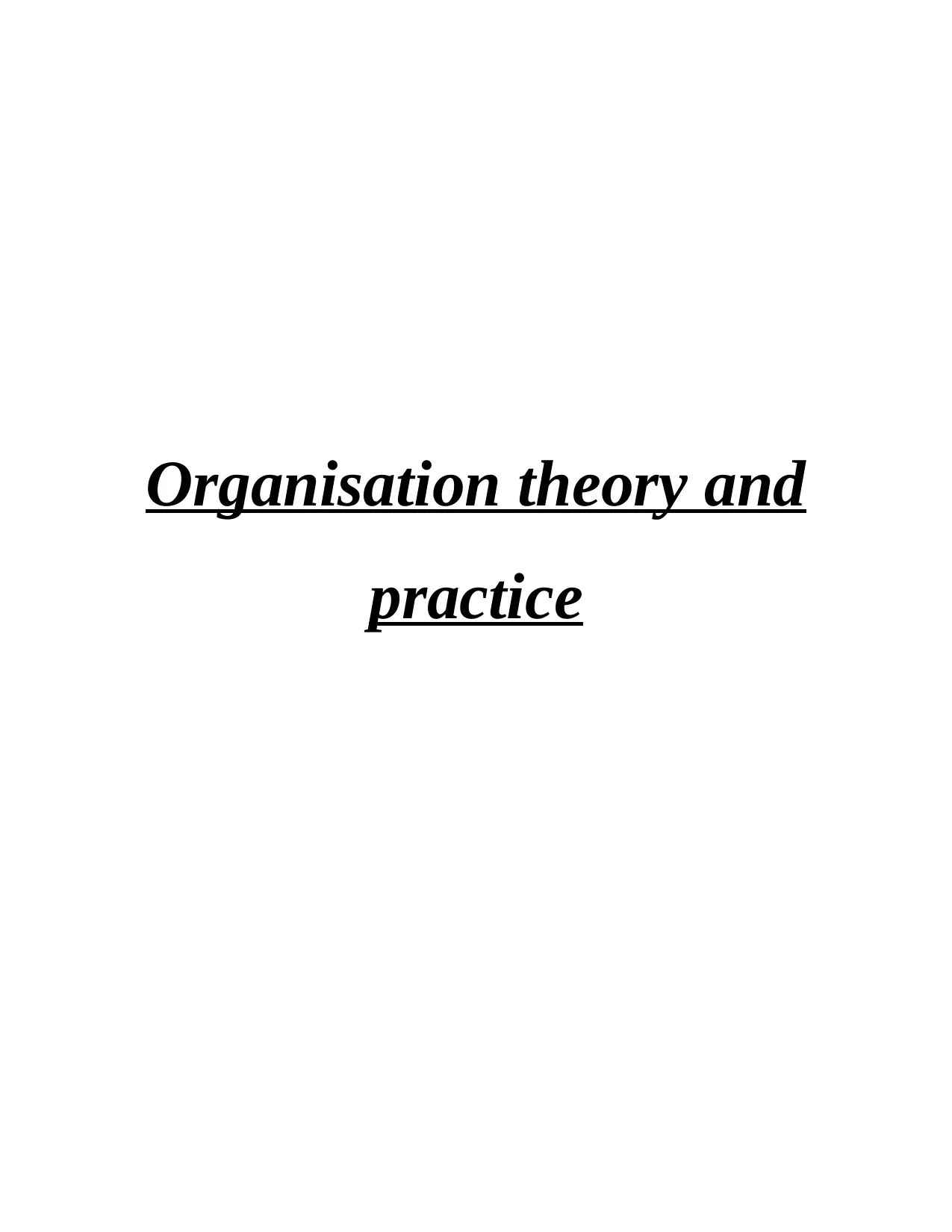
Organisation theory and
practice
practice
Secure Best Marks with AI Grader
Need help grading? Try our AI Grader for instant feedback on your assignments.
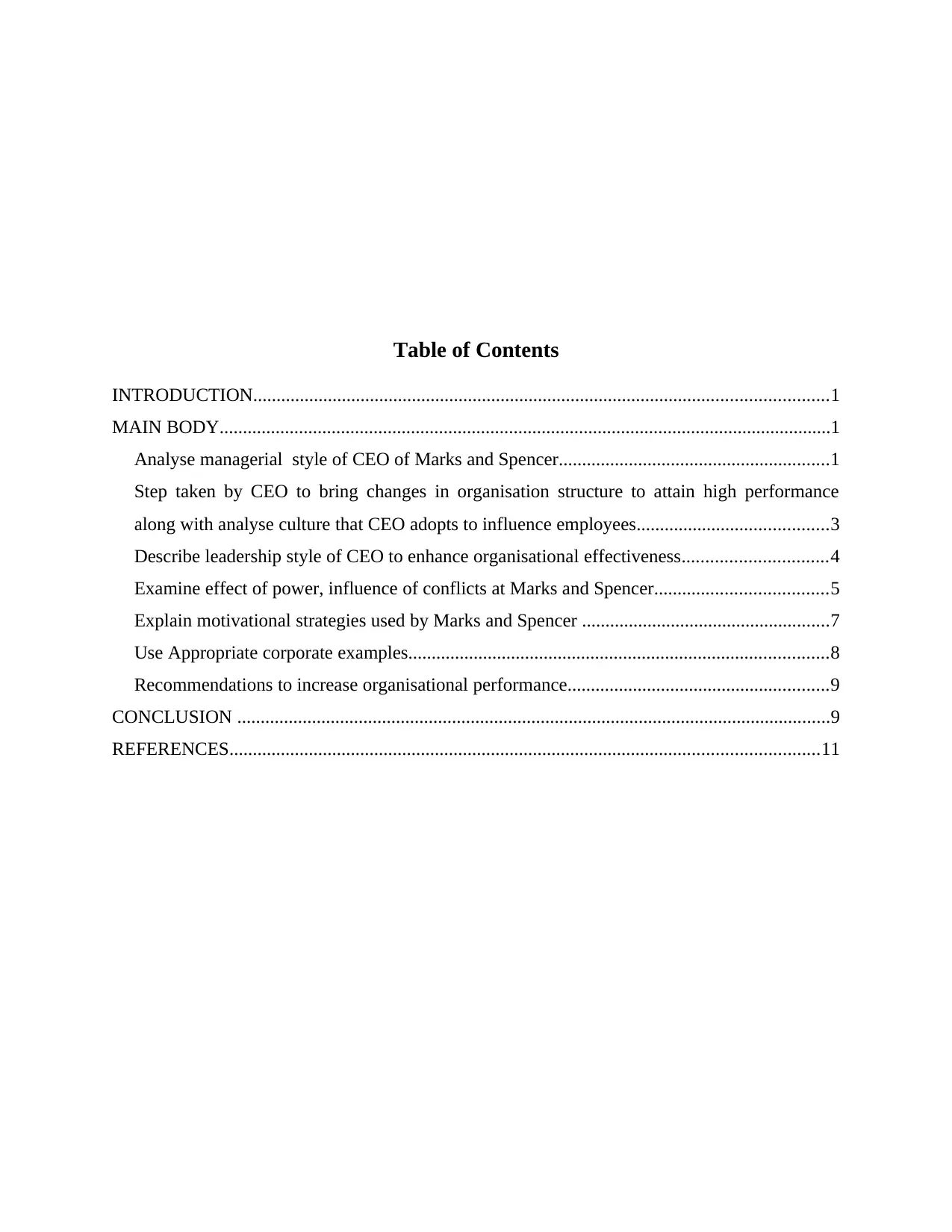
Table of Contents
INTRODUCTION...........................................................................................................................1
MAIN BODY...................................................................................................................................1
Analyse managerial style of CEO of Marks and Spencer..........................................................1
Step taken by CEO to bring changes in organisation structure to attain high performance
along with analyse culture that CEO adopts to influence employees.........................................3
Describe leadership style of CEO to enhance organisational effectiveness...............................4
Examine effect of power, influence of conflicts at Marks and Spencer.....................................5
Explain motivational strategies used by Marks and Spencer .....................................................7
Use Appropriate corporate examples..........................................................................................8
Recommendations to increase organisational performance........................................................9
CONCLUSION ...............................................................................................................................9
REFERENCES..............................................................................................................................11
INTRODUCTION...........................................................................................................................1
MAIN BODY...................................................................................................................................1
Analyse managerial style of CEO of Marks and Spencer..........................................................1
Step taken by CEO to bring changes in organisation structure to attain high performance
along with analyse culture that CEO adopts to influence employees.........................................3
Describe leadership style of CEO to enhance organisational effectiveness...............................4
Examine effect of power, influence of conflicts at Marks and Spencer.....................................5
Explain motivational strategies used by Marks and Spencer .....................................................7
Use Appropriate corporate examples..........................................................................................8
Recommendations to increase organisational performance........................................................9
CONCLUSION ...............................................................................................................................9
REFERENCES..............................................................................................................................11
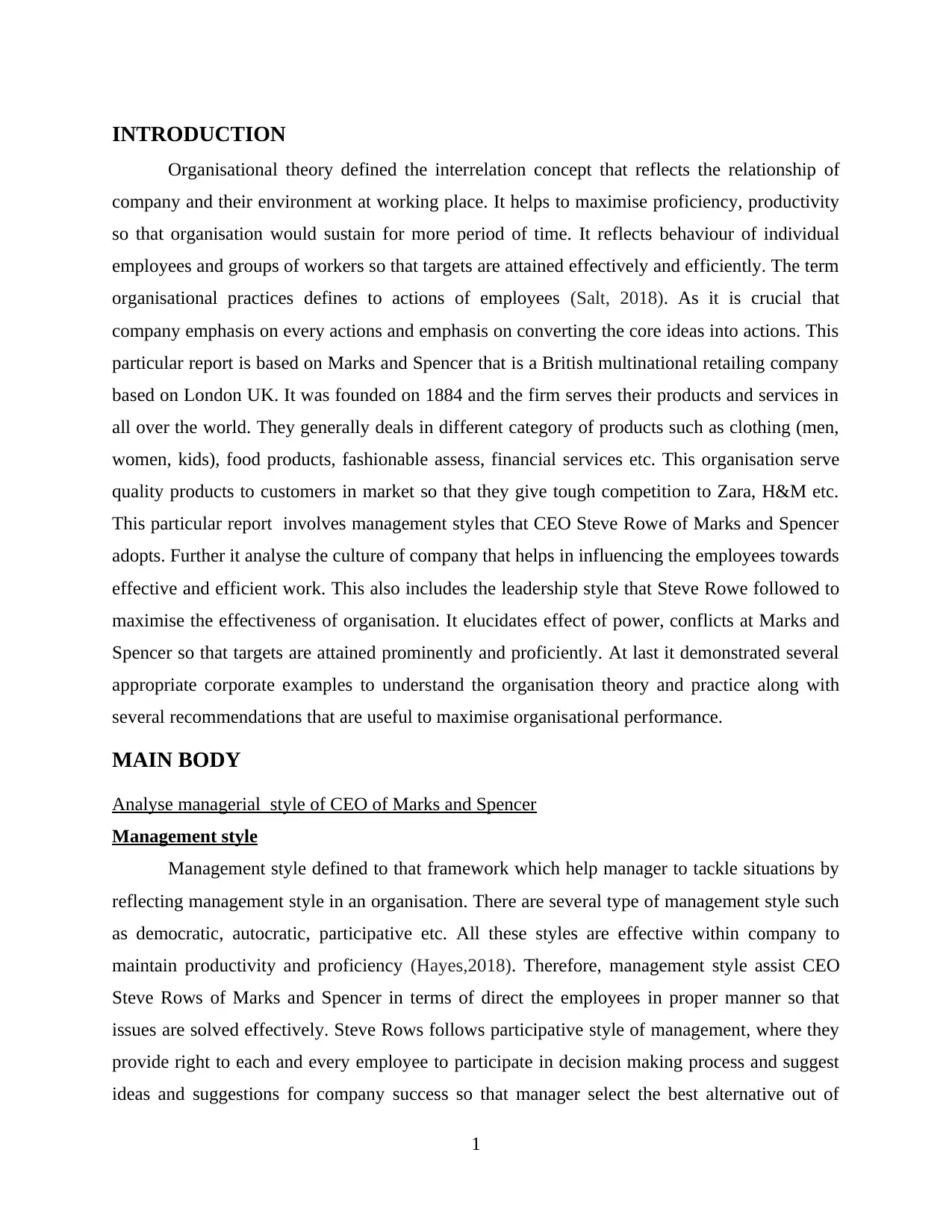
INTRODUCTION
Organisational theory defined the interrelation concept that reflects the relationship of
company and their environment at working place. It helps to maximise proficiency, productivity
so that organisation would sustain for more period of time. It reflects behaviour of individual
employees and groups of workers so that targets are attained effectively and efficiently. The term
organisational practices defines to actions of employees (Salt, 2018). As it is crucial that
company emphasis on every actions and emphasis on converting the core ideas into actions. This
particular report is based on Marks and Spencer that is a British multinational retailing company
based on London UK. It was founded on 1884 and the firm serves their products and services in
all over the world. They generally deals in different category of products such as clothing (men,
women, kids), food products, fashionable assess, financial services etc. This organisation serve
quality products to customers in market so that they give tough competition to Zara, H&M etc.
This particular report involves management styles that CEO Steve Rowe of Marks and Spencer
adopts. Further it analyse the culture of company that helps in influencing the employees towards
effective and efficient work. This also includes the leadership style that Steve Rowe followed to
maximise the effectiveness of organisation. It elucidates effect of power, conflicts at Marks and
Spencer so that targets are attained prominently and proficiently. At last it demonstrated several
appropriate corporate examples to understand the organisation theory and practice along with
several recommendations that are useful to maximise organisational performance.
MAIN BODY
Analyse managerial style of CEO of Marks and Spencer
Management style
Management style defined to that framework which help manager to tackle situations by
reflecting management style in an organisation. There are several type of management style such
as democratic, autocratic, participative etc. All these styles are effective within company to
maintain productivity and proficiency (Hayes,2018). Therefore, management style assist CEO
Steve Rows of Marks and Spencer in terms of direct the employees in proper manner so that
issues are solved effectively. Steve Rows follows participative style of management, where they
provide right to each and every employee to participate in decision making process and suggest
ideas and suggestions for company success so that manager select the best alternative out of
1
Organisational theory defined the interrelation concept that reflects the relationship of
company and their environment at working place. It helps to maximise proficiency, productivity
so that organisation would sustain for more period of time. It reflects behaviour of individual
employees and groups of workers so that targets are attained effectively and efficiently. The term
organisational practices defines to actions of employees (Salt, 2018). As it is crucial that
company emphasis on every actions and emphasis on converting the core ideas into actions. This
particular report is based on Marks and Spencer that is a British multinational retailing company
based on London UK. It was founded on 1884 and the firm serves their products and services in
all over the world. They generally deals in different category of products such as clothing (men,
women, kids), food products, fashionable assess, financial services etc. This organisation serve
quality products to customers in market so that they give tough competition to Zara, H&M etc.
This particular report involves management styles that CEO Steve Rowe of Marks and Spencer
adopts. Further it analyse the culture of company that helps in influencing the employees towards
effective and efficient work. This also includes the leadership style that Steve Rowe followed to
maximise the effectiveness of organisation. It elucidates effect of power, conflicts at Marks and
Spencer so that targets are attained prominently and proficiently. At last it demonstrated several
appropriate corporate examples to understand the organisation theory and practice along with
several recommendations that are useful to maximise organisational performance.
MAIN BODY
Analyse managerial style of CEO of Marks and Spencer
Management style
Management style defined to that framework which help manager to tackle situations by
reflecting management style in an organisation. There are several type of management style such
as democratic, autocratic, participative etc. All these styles are effective within company to
maintain productivity and proficiency (Hayes,2018). Therefore, management style assist CEO
Steve Rows of Marks and Spencer in terms of direct the employees in proper manner so that
issues are solved effectively. Steve Rows follows participative style of management, where they
provide right to each and every employee to participate in decision making process and suggest
ideas and suggestions for company success so that manager select the best alternative out of
1
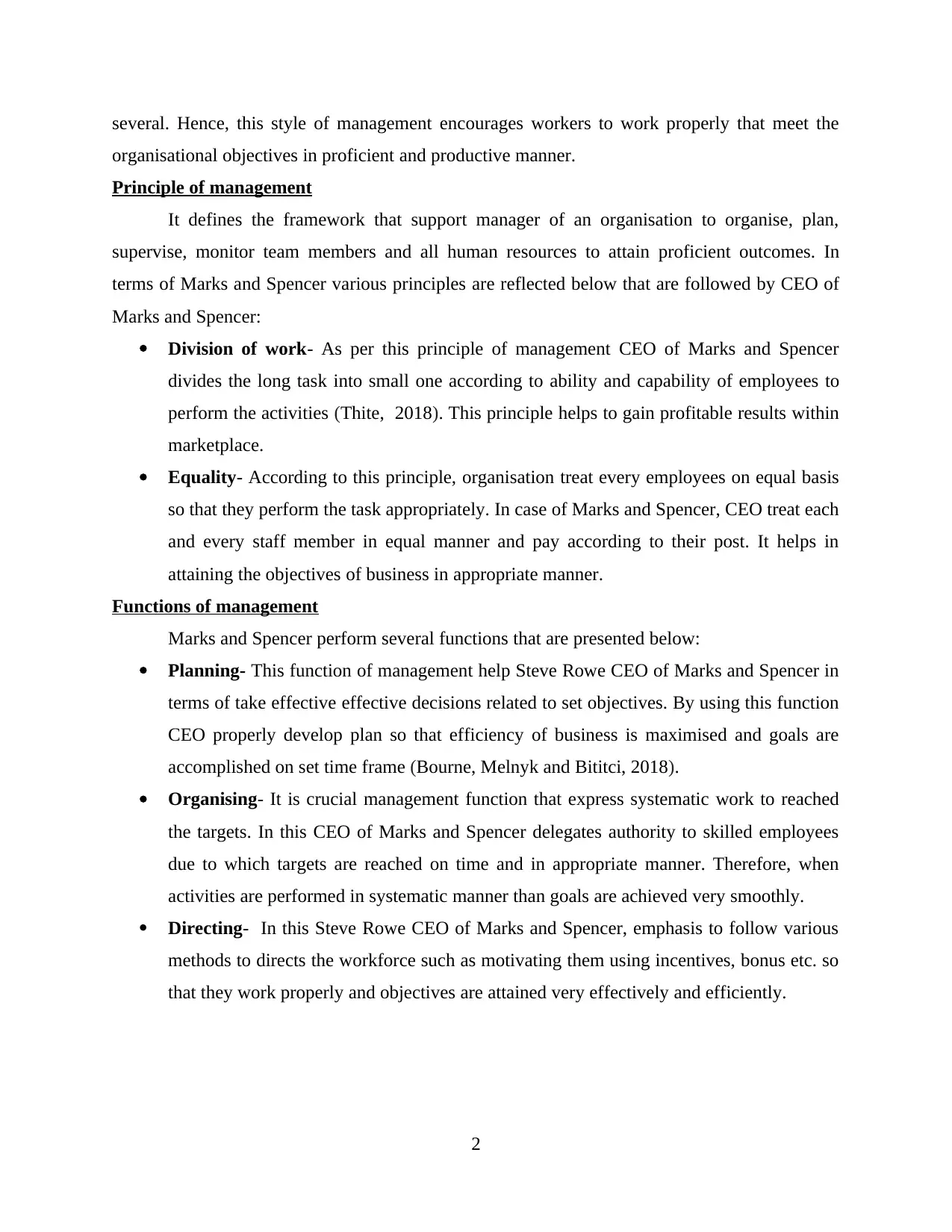
several. Hence, this style of management encourages workers to work properly that meet the
organisational objectives in proficient and productive manner.
Principle of management
It defines the framework that support manager of an organisation to organise, plan,
supervise, monitor team members and all human resources to attain proficient outcomes. In
terms of Marks and Spencer various principles are reflected below that are followed by CEO of
Marks and Spencer:
Division of work- As per this principle of management CEO of Marks and Spencer
divides the long task into small one according to ability and capability of employees to
perform the activities (Thite, 2018). This principle helps to gain profitable results within
marketplace.
Equality- According to this principle, organisation treat every employees on equal basis
so that they perform the task appropriately. In case of Marks and Spencer, CEO treat each
and every staff member in equal manner and pay according to their post. It helps in
attaining the objectives of business in appropriate manner.
Functions of management
Marks and Spencer perform several functions that are presented below:
Planning- This function of management help Steve Rowe CEO of Marks and Spencer in
terms of take effective effective decisions related to set objectives. By using this function
CEO properly develop plan so that efficiency of business is maximised and goals are
accomplished on set time frame (Bourne, Melnyk and Bititci, 2018).
Organising- It is crucial management function that express systematic work to reached
the targets. In this CEO of Marks and Spencer delegates authority to skilled employees
due to which targets are reached on time and in appropriate manner. Therefore, when
activities are performed in systematic manner than goals are achieved very smoothly.
Directing- In this Steve Rowe CEO of Marks and Spencer, emphasis to follow various
methods to directs the workforce such as motivating them using incentives, bonus etc. so
that they work properly and objectives are attained very effectively and efficiently.
2
organisational objectives in proficient and productive manner.
Principle of management
It defines the framework that support manager of an organisation to organise, plan,
supervise, monitor team members and all human resources to attain proficient outcomes. In
terms of Marks and Spencer various principles are reflected below that are followed by CEO of
Marks and Spencer:
Division of work- As per this principle of management CEO of Marks and Spencer
divides the long task into small one according to ability and capability of employees to
perform the activities (Thite, 2018). This principle helps to gain profitable results within
marketplace.
Equality- According to this principle, organisation treat every employees on equal basis
so that they perform the task appropriately. In case of Marks and Spencer, CEO treat each
and every staff member in equal manner and pay according to their post. It helps in
attaining the objectives of business in appropriate manner.
Functions of management
Marks and Spencer perform several functions that are presented below:
Planning- This function of management help Steve Rowe CEO of Marks and Spencer in
terms of take effective effective decisions related to set objectives. By using this function
CEO properly develop plan so that efficiency of business is maximised and goals are
accomplished on set time frame (Bourne, Melnyk and Bititci, 2018).
Organising- It is crucial management function that express systematic work to reached
the targets. In this CEO of Marks and Spencer delegates authority to skilled employees
due to which targets are reached on time and in appropriate manner. Therefore, when
activities are performed in systematic manner than goals are achieved very smoothly.
Directing- In this Steve Rowe CEO of Marks and Spencer, emphasis to follow various
methods to directs the workforce such as motivating them using incentives, bonus etc. so
that they work properly and objectives are attained very effectively and efficiently.
2
Secure Best Marks with AI Grader
Need help grading? Try our AI Grader for instant feedback on your assignments.
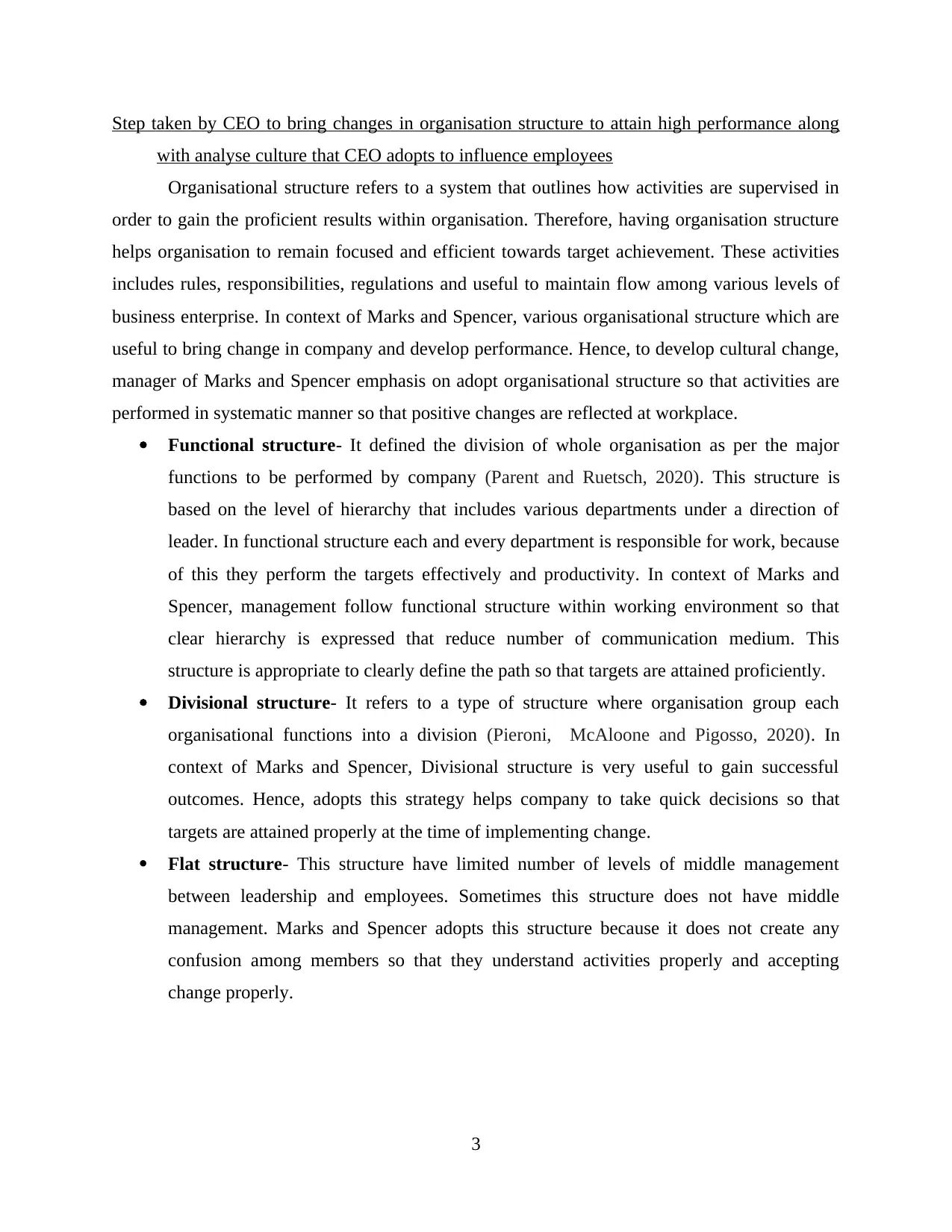
Step taken by CEO to bring changes in organisation structure to attain high performance along
with analyse culture that CEO adopts to influence employees
Organisational structure refers to a system that outlines how activities are supervised in
order to gain the proficient results within organisation. Therefore, having organisation structure
helps organisation to remain focused and efficient towards target achievement. These activities
includes rules, responsibilities, regulations and useful to maintain flow among various levels of
business enterprise. In context of Marks and Spencer, various organisational structure which are
useful to bring change in company and develop performance. Hence, to develop cultural change,
manager of Marks and Spencer emphasis on adopt organisational structure so that activities are
performed in systematic manner so that positive changes are reflected at workplace.
Functional structure- It defined the division of whole organisation as per the major
functions to be performed by company (Parent and Ruetsch, 2020). This structure is
based on the level of hierarchy that includes various departments under a direction of
leader. In functional structure each and every department is responsible for work, because
of this they perform the targets effectively and productivity. In context of Marks and
Spencer, management follow functional structure within working environment so that
clear hierarchy is expressed that reduce number of communication medium. This
structure is appropriate to clearly define the path so that targets are attained proficiently.
Divisional structure- It refers to a type of structure where organisation group each
organisational functions into a division (Pieroni, McAloone and Pigosso, 2020). In
context of Marks and Spencer, Divisional structure is very useful to gain successful
outcomes. Hence, adopts this strategy helps company to take quick decisions so that
targets are attained properly at the time of implementing change.
Flat structure- This structure have limited number of levels of middle management
between leadership and employees. Sometimes this structure does not have middle
management. Marks and Spencer adopts this structure because it does not create any
confusion among members so that they understand activities properly and accepting
change properly.
3
with analyse culture that CEO adopts to influence employees
Organisational structure refers to a system that outlines how activities are supervised in
order to gain the proficient results within organisation. Therefore, having organisation structure
helps organisation to remain focused and efficient towards target achievement. These activities
includes rules, responsibilities, regulations and useful to maintain flow among various levels of
business enterprise. In context of Marks and Spencer, various organisational structure which are
useful to bring change in company and develop performance. Hence, to develop cultural change,
manager of Marks and Spencer emphasis on adopt organisational structure so that activities are
performed in systematic manner so that positive changes are reflected at workplace.
Functional structure- It defined the division of whole organisation as per the major
functions to be performed by company (Parent and Ruetsch, 2020). This structure is
based on the level of hierarchy that includes various departments under a direction of
leader. In functional structure each and every department is responsible for work, because
of this they perform the targets effectively and productivity. In context of Marks and
Spencer, management follow functional structure within working environment so that
clear hierarchy is expressed that reduce number of communication medium. This
structure is appropriate to clearly define the path so that targets are attained proficiently.
Divisional structure- It refers to a type of structure where organisation group each
organisational functions into a division (Pieroni, McAloone and Pigosso, 2020). In
context of Marks and Spencer, Divisional structure is very useful to gain successful
outcomes. Hence, adopts this strategy helps company to take quick decisions so that
targets are attained properly at the time of implementing change.
Flat structure- This structure have limited number of levels of middle management
between leadership and employees. Sometimes this structure does not have middle
management. Marks and Spencer adopts this structure because it does not create any
confusion among members so that they understand activities properly and accepting
change properly.
3
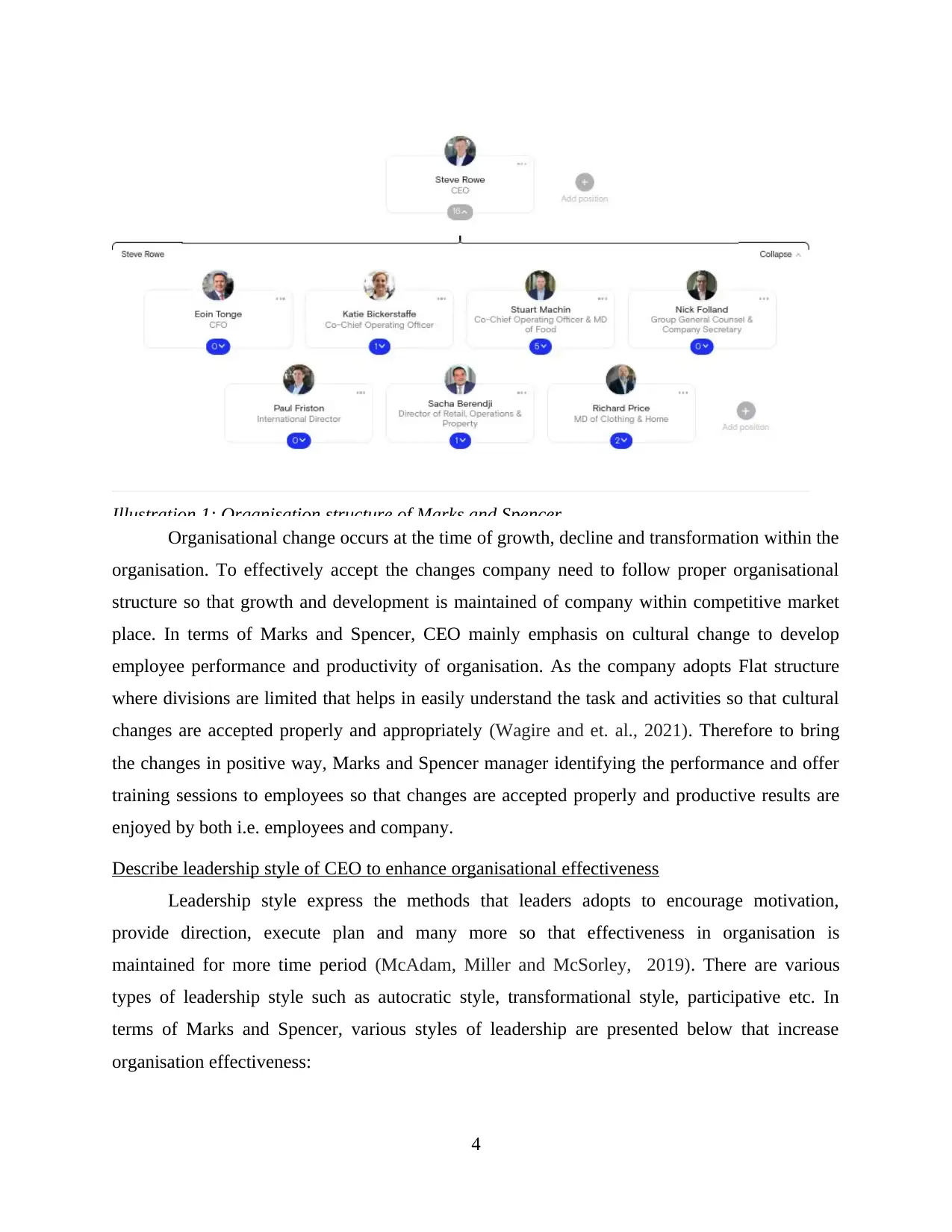
Illustration 1: Organisation structure of Marks and Spencer
Organisational change occurs at the time of growth, decline and transformation within the
organisation. To effectively accept the changes company need to follow proper organisational
structure so that growth and development is maintained of company within competitive market
place. In terms of Marks and Spencer, CEO mainly emphasis on cultural change to develop
employee performance and productivity of organisation. As the company adopts Flat structure
where divisions are limited that helps in easily understand the task and activities so that cultural
changes are accepted properly and appropriately (Wagire and et. al., 2021). Therefore to bring
the changes in positive way, Marks and Spencer manager identifying the performance and offer
training sessions to employees so that changes are accepted properly and productive results are
enjoyed by both i.e. employees and company.
Describe leadership style of CEO to enhance organisational effectiveness
Leadership style express the methods that leaders adopts to encourage motivation,
provide direction, execute plan and many more so that effectiveness in organisation is
maintained for more time period (McAdam, Miller and McSorley, 2019). There are various
types of leadership style such as autocratic style, transformational style, participative etc. In
terms of Marks and Spencer, various styles of leadership are presented below that increase
organisation effectiveness:
4
Organisational change occurs at the time of growth, decline and transformation within the
organisation. To effectively accept the changes company need to follow proper organisational
structure so that growth and development is maintained of company within competitive market
place. In terms of Marks and Spencer, CEO mainly emphasis on cultural change to develop
employee performance and productivity of organisation. As the company adopts Flat structure
where divisions are limited that helps in easily understand the task and activities so that cultural
changes are accepted properly and appropriately (Wagire and et. al., 2021). Therefore to bring
the changes in positive way, Marks and Spencer manager identifying the performance and offer
training sessions to employees so that changes are accepted properly and productive results are
enjoyed by both i.e. employees and company.
Describe leadership style of CEO to enhance organisational effectiveness
Leadership style express the methods that leaders adopts to encourage motivation,
provide direction, execute plan and many more so that effectiveness in organisation is
maintained for more time period (McAdam, Miller and McSorley, 2019). There are various
types of leadership style such as autocratic style, transformational style, participative etc. In
terms of Marks and Spencer, various styles of leadership are presented below that increase
organisation effectiveness:
4
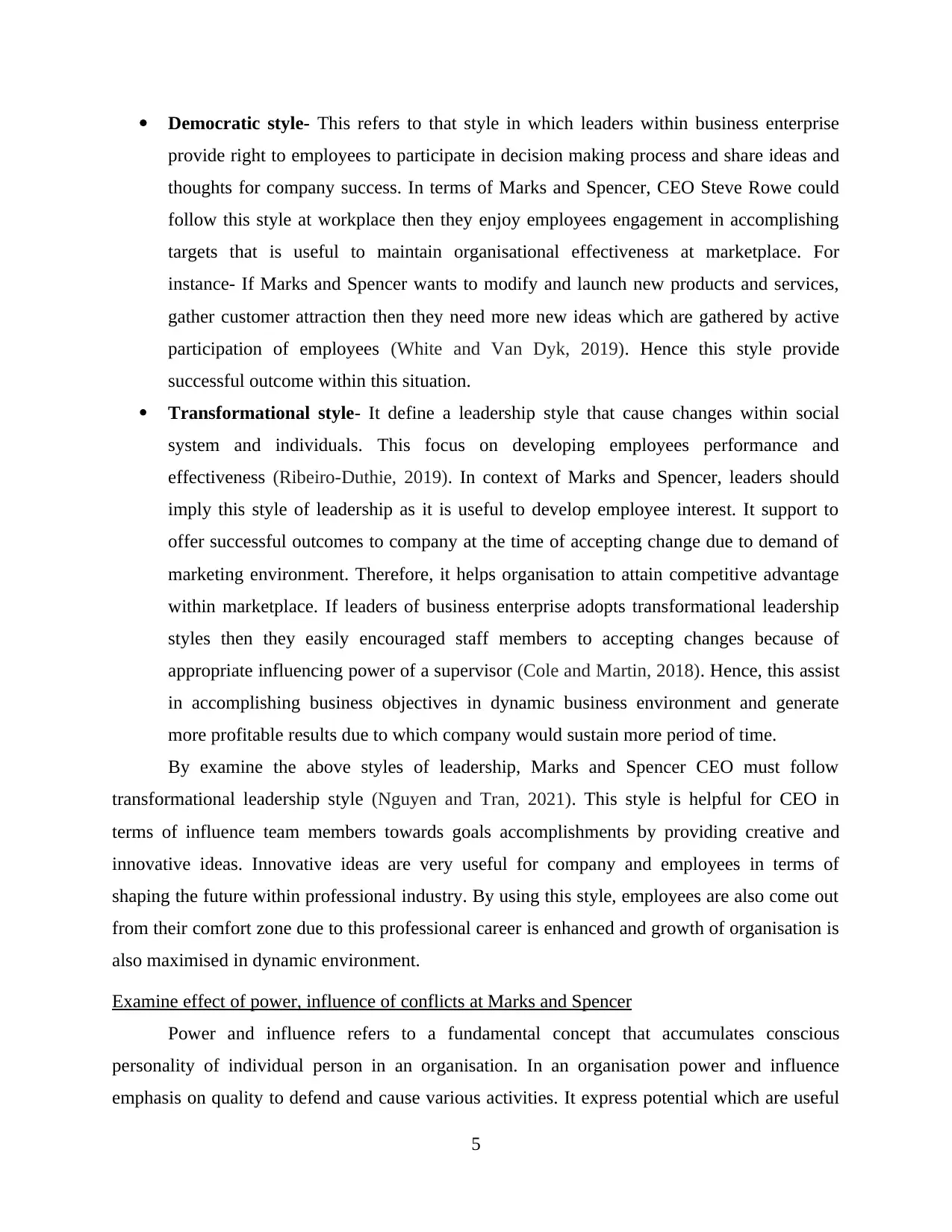
Democratic style- This refers to that style in which leaders within business enterprise
provide right to employees to participate in decision making process and share ideas and
thoughts for company success. In terms of Marks and Spencer, CEO Steve Rowe could
follow this style at workplace then they enjoy employees engagement in accomplishing
targets that is useful to maintain organisational effectiveness at marketplace. For
instance- If Marks and Spencer wants to modify and launch new products and services,
gather customer attraction then they need more new ideas which are gathered by active
participation of employees (White and Van Dyk, 2019). Hence this style provide
successful outcome within this situation.
Transformational style- It define a leadership style that cause changes within social
system and individuals. This focus on developing employees performance and
effectiveness (Ribeiro-Duthie, 2019). In context of Marks and Spencer, leaders should
imply this style of leadership as it is useful to develop employee interest. It support to
offer successful outcomes to company at the time of accepting change due to demand of
marketing environment. Therefore, it helps organisation to attain competitive advantage
within marketplace. If leaders of business enterprise adopts transformational leadership
styles then they easily encouraged staff members to accepting changes because of
appropriate influencing power of a supervisor (Cole and Martin, 2018). Hence, this assist
in accomplishing business objectives in dynamic business environment and generate
more profitable results due to which company would sustain more period of time.
By examine the above styles of leadership, Marks and Spencer CEO must follow
transformational leadership style (Nguyen and Tran, 2021). This style is helpful for CEO in
terms of influence team members towards goals accomplishments by providing creative and
innovative ideas. Innovative ideas are very useful for company and employees in terms of
shaping the future within professional industry. By using this style, employees are also come out
from their comfort zone due to this professional career is enhanced and growth of organisation is
also maximised in dynamic environment.
Examine effect of power, influence of conflicts at Marks and Spencer
Power and influence refers to a fundamental concept that accumulates conscious
personality of individual person in an organisation. In an organisation power and influence
emphasis on quality to defend and cause various activities. It express potential which are useful
5
provide right to employees to participate in decision making process and share ideas and
thoughts for company success. In terms of Marks and Spencer, CEO Steve Rowe could
follow this style at workplace then they enjoy employees engagement in accomplishing
targets that is useful to maintain organisational effectiveness at marketplace. For
instance- If Marks and Spencer wants to modify and launch new products and services,
gather customer attraction then they need more new ideas which are gathered by active
participation of employees (White and Van Dyk, 2019). Hence this style provide
successful outcome within this situation.
Transformational style- It define a leadership style that cause changes within social
system and individuals. This focus on developing employees performance and
effectiveness (Ribeiro-Duthie, 2019). In context of Marks and Spencer, leaders should
imply this style of leadership as it is useful to develop employee interest. It support to
offer successful outcomes to company at the time of accepting change due to demand of
marketing environment. Therefore, it helps organisation to attain competitive advantage
within marketplace. If leaders of business enterprise adopts transformational leadership
styles then they easily encouraged staff members to accepting changes because of
appropriate influencing power of a supervisor (Cole and Martin, 2018). Hence, this assist
in accomplishing business objectives in dynamic business environment and generate
more profitable results due to which company would sustain more period of time.
By examine the above styles of leadership, Marks and Spencer CEO must follow
transformational leadership style (Nguyen and Tran, 2021). This style is helpful for CEO in
terms of influence team members towards goals accomplishments by providing creative and
innovative ideas. Innovative ideas are very useful for company and employees in terms of
shaping the future within professional industry. By using this style, employees are also come out
from their comfort zone due to this professional career is enhanced and growth of organisation is
also maximised in dynamic environment.
Examine effect of power, influence of conflicts at Marks and Spencer
Power and influence refers to a fundamental concept that accumulates conscious
personality of individual person in an organisation. In an organisation power and influence
emphasis on quality to defend and cause various activities. It express potential which are useful
5
Paraphrase This Document
Need a fresh take? Get an instant paraphrase of this document with our AI Paraphraser
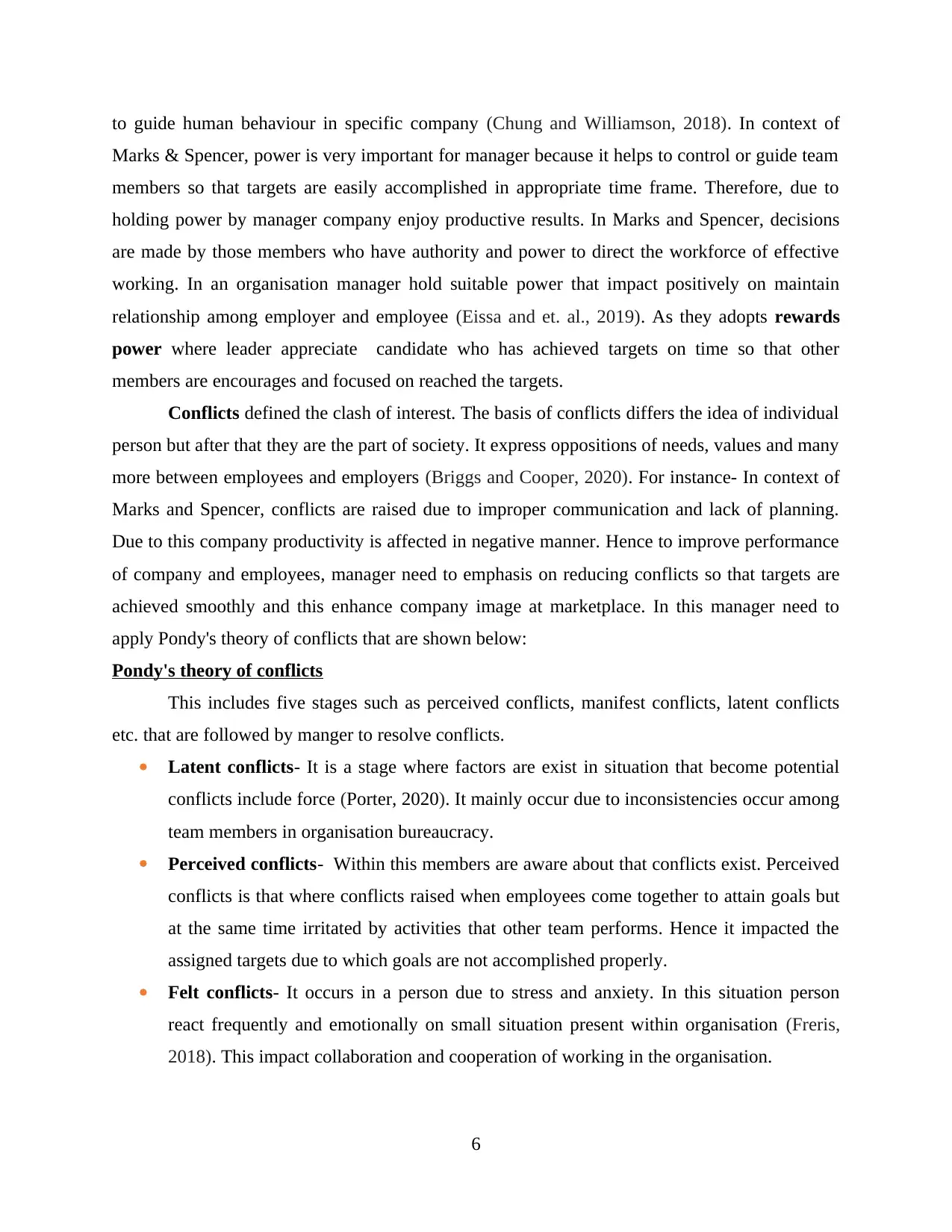
to guide human behaviour in specific company (Chung and Williamson, 2018). In context of
Marks & Spencer, power is very important for manager because it helps to control or guide team
members so that targets are easily accomplished in appropriate time frame. Therefore, due to
holding power by manager company enjoy productive results. In Marks and Spencer, decisions
are made by those members who have authority and power to direct the workforce of effective
working. In an organisation manager hold suitable power that impact positively on maintain
relationship among employer and employee (Eissa and et. al., 2019). As they adopts rewards
power where leader appreciate candidate who has achieved targets on time so that other
members are encourages and focused on reached the targets.
Conflicts defined the clash of interest. The basis of conflicts differs the idea of individual
person but after that they are the part of society. It express oppositions of needs, values and many
more between employees and employers (Briggs and Cooper, 2020). For instance- In context of
Marks and Spencer, conflicts are raised due to improper communication and lack of planning.
Due to this company productivity is affected in negative manner. Hence to improve performance
of company and employees, manager need to emphasis on reducing conflicts so that targets are
achieved smoothly and this enhance company image at marketplace. In this manager need to
apply Pondy's theory of conflicts that are shown below:
Pondy's theory of conflicts
This includes five stages such as perceived conflicts, manifest conflicts, latent conflicts
etc. that are followed by manger to resolve conflicts.
Latent conflicts- It is a stage where factors are exist in situation that become potential
conflicts include force (Porter, 2020). It mainly occur due to inconsistencies occur among
team members in organisation bureaucracy.
Perceived conflicts- Within this members are aware about that conflicts exist. Perceived
conflicts is that where conflicts raised when employees come together to attain goals but
at the same time irritated by activities that other team performs. Hence it impacted the
assigned targets due to which goals are not accomplished properly.
Felt conflicts- It occurs in a person due to stress and anxiety. In this situation person
react frequently and emotionally on small situation present within organisation (Freris,
2018). This impact collaboration and cooperation of working in the organisation.
6
Marks & Spencer, power is very important for manager because it helps to control or guide team
members so that targets are easily accomplished in appropriate time frame. Therefore, due to
holding power by manager company enjoy productive results. In Marks and Spencer, decisions
are made by those members who have authority and power to direct the workforce of effective
working. In an organisation manager hold suitable power that impact positively on maintain
relationship among employer and employee (Eissa and et. al., 2019). As they adopts rewards
power where leader appreciate candidate who has achieved targets on time so that other
members are encourages and focused on reached the targets.
Conflicts defined the clash of interest. The basis of conflicts differs the idea of individual
person but after that they are the part of society. It express oppositions of needs, values and many
more between employees and employers (Briggs and Cooper, 2020). For instance- In context of
Marks and Spencer, conflicts are raised due to improper communication and lack of planning.
Due to this company productivity is affected in negative manner. Hence to improve performance
of company and employees, manager need to emphasis on reducing conflicts so that targets are
achieved smoothly and this enhance company image at marketplace. In this manager need to
apply Pondy's theory of conflicts that are shown below:
Pondy's theory of conflicts
This includes five stages such as perceived conflicts, manifest conflicts, latent conflicts
etc. that are followed by manger to resolve conflicts.
Latent conflicts- It is a stage where factors are exist in situation that become potential
conflicts include force (Porter, 2020). It mainly occur due to inconsistencies occur among
team members in organisation bureaucracy.
Perceived conflicts- Within this members are aware about that conflicts exist. Perceived
conflicts is that where conflicts raised when employees come together to attain goals but
at the same time irritated by activities that other team performs. Hence it impacted the
assigned targets due to which goals are not accomplished properly.
Felt conflicts- It occurs in a person due to stress and anxiety. In this situation person
react frequently and emotionally on small situation present within organisation (Freris,
2018). This impact collaboration and cooperation of working in the organisation.
6
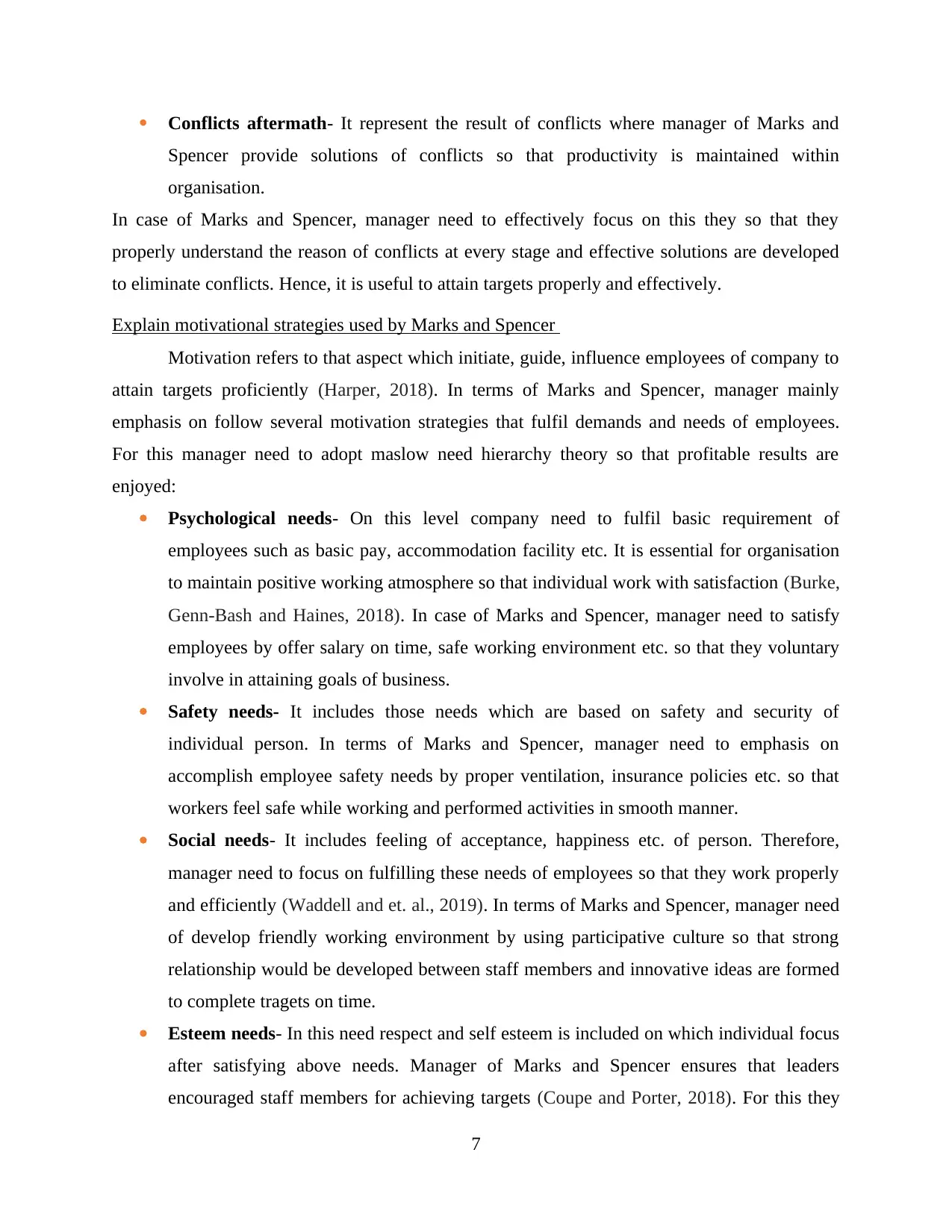
Conflicts aftermath- It represent the result of conflicts where manager of Marks and
Spencer provide solutions of conflicts so that productivity is maintained within
organisation.
In case of Marks and Spencer, manager need to effectively focus on this they so that they
properly understand the reason of conflicts at every stage and effective solutions are developed
to eliminate conflicts. Hence, it is useful to attain targets properly and effectively.
Explain motivational strategies used by Marks and Spencer
Motivation refers to that aspect which initiate, guide, influence employees of company to
attain targets proficiently (Harper, 2018). In terms of Marks and Spencer, manager mainly
emphasis on follow several motivation strategies that fulfil demands and needs of employees.
For this manager need to adopt maslow need hierarchy theory so that profitable results are
enjoyed:
Psychological needs- On this level company need to fulfil basic requirement of
employees such as basic pay, accommodation facility etc. It is essential for organisation
to maintain positive working atmosphere so that individual work with satisfaction (Burke,
Genn-Bash and Haines, 2018). In case of Marks and Spencer, manager need to satisfy
employees by offer salary on time, safe working environment etc. so that they voluntary
involve in attaining goals of business.
Safety needs- It includes those needs which are based on safety and security of
individual person. In terms of Marks and Spencer, manager need to emphasis on
accomplish employee safety needs by proper ventilation, insurance policies etc. so that
workers feel safe while working and performed activities in smooth manner.
Social needs- It includes feeling of acceptance, happiness etc. of person. Therefore,
manager need to focus on fulfilling these needs of employees so that they work properly
and efficiently (Waddell and et. al., 2019). In terms of Marks and Spencer, manager need
of develop friendly working environment by using participative culture so that strong
relationship would be developed between staff members and innovative ideas are formed
to complete tragets on time.
Esteem needs- In this need respect and self esteem is included on which individual focus
after satisfying above needs. Manager of Marks and Spencer ensures that leaders
encouraged staff members for achieving targets (Coupe and Porter, 2018). For this they
7
Spencer provide solutions of conflicts so that productivity is maintained within
organisation.
In case of Marks and Spencer, manager need to effectively focus on this they so that they
properly understand the reason of conflicts at every stage and effective solutions are developed
to eliminate conflicts. Hence, it is useful to attain targets properly and effectively.
Explain motivational strategies used by Marks and Spencer
Motivation refers to that aspect which initiate, guide, influence employees of company to
attain targets proficiently (Harper, 2018). In terms of Marks and Spencer, manager mainly
emphasis on follow several motivation strategies that fulfil demands and needs of employees.
For this manager need to adopt maslow need hierarchy theory so that profitable results are
enjoyed:
Psychological needs- On this level company need to fulfil basic requirement of
employees such as basic pay, accommodation facility etc. It is essential for organisation
to maintain positive working atmosphere so that individual work with satisfaction (Burke,
Genn-Bash and Haines, 2018). In case of Marks and Spencer, manager need to satisfy
employees by offer salary on time, safe working environment etc. so that they voluntary
involve in attaining goals of business.
Safety needs- It includes those needs which are based on safety and security of
individual person. In terms of Marks and Spencer, manager need to emphasis on
accomplish employee safety needs by proper ventilation, insurance policies etc. so that
workers feel safe while working and performed activities in smooth manner.
Social needs- It includes feeling of acceptance, happiness etc. of person. Therefore,
manager need to focus on fulfilling these needs of employees so that they work properly
and efficiently (Waddell and et. al., 2019). In terms of Marks and Spencer, manager need
of develop friendly working environment by using participative culture so that strong
relationship would be developed between staff members and innovative ideas are formed
to complete tragets on time.
Esteem needs- In this need respect and self esteem is included on which individual focus
after satisfying above needs. Manager of Marks and Spencer ensures that leaders
encouraged staff members for achieving targets (Coupe and Porter, 2018). For this they
7
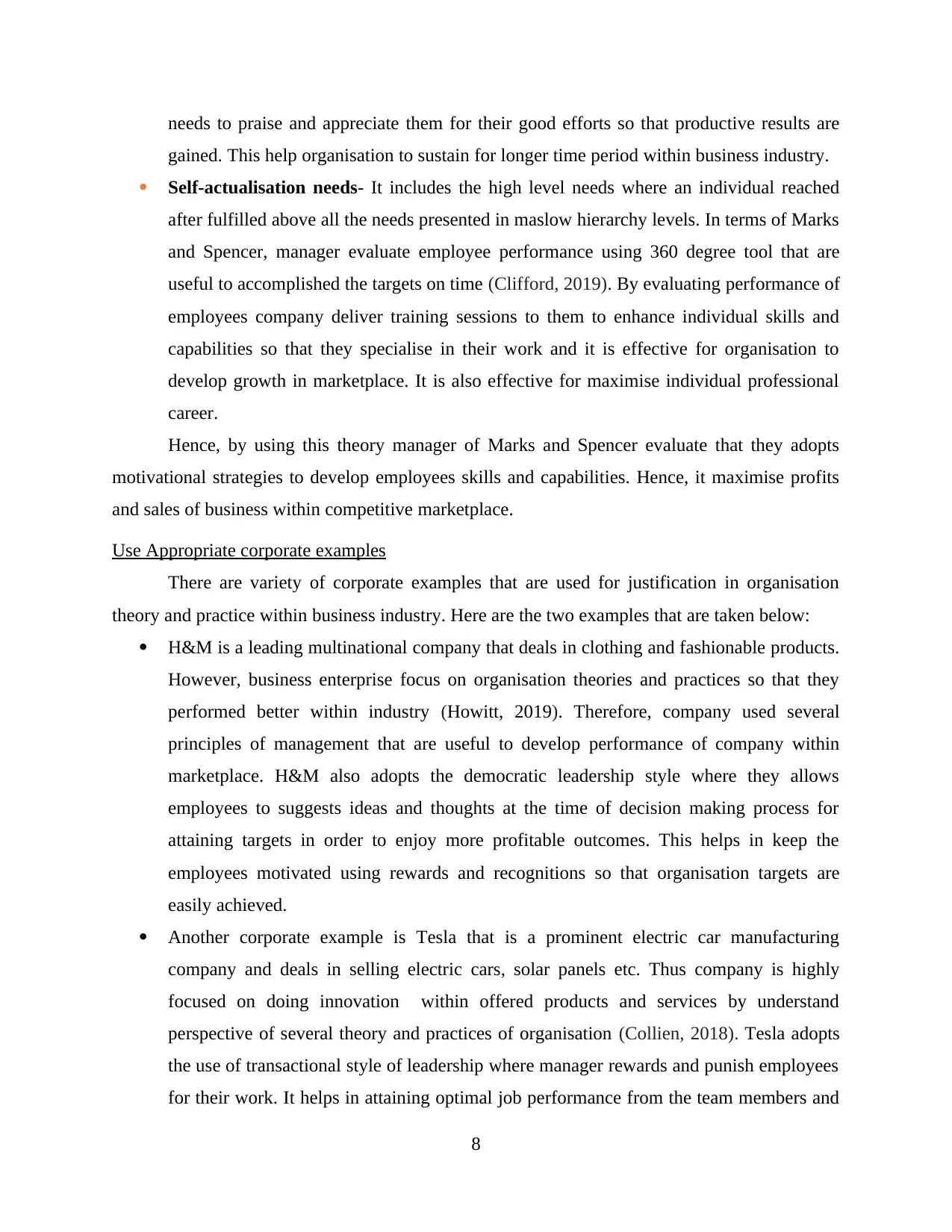
needs to praise and appreciate them for their good efforts so that productive results are
gained. This help organisation to sustain for longer time period within business industry.
Self-actualisation needs- It includes the high level needs where an individual reached
after fulfilled above all the needs presented in maslow hierarchy levels. In terms of Marks
and Spencer, manager evaluate employee performance using 360 degree tool that are
useful to accomplished the targets on time (Clifford, 2019). By evaluating performance of
employees company deliver training sessions to them to enhance individual skills and
capabilities so that they specialise in their work and it is effective for organisation to
develop growth in marketplace. It is also effective for maximise individual professional
career.
Hence, by using this theory manager of Marks and Spencer evaluate that they adopts
motivational strategies to develop employees skills and capabilities. Hence, it maximise profits
and sales of business within competitive marketplace.
Use Appropriate corporate examples
There are variety of corporate examples that are used for justification in organisation
theory and practice within business industry. Here are the two examples that are taken below:
H&M is a leading multinational company that deals in clothing and fashionable products.
However, business enterprise focus on organisation theories and practices so that they
performed better within industry (Howitt, 2019). Therefore, company used several
principles of management that are useful to develop performance of company within
marketplace. H&M also adopts the democratic leadership style where they allows
employees to suggests ideas and thoughts at the time of decision making process for
attaining targets in order to enjoy more profitable outcomes. This helps in keep the
employees motivated using rewards and recognitions so that organisation targets are
easily achieved.
Another corporate example is Tesla that is a prominent electric car manufacturing
company and deals in selling electric cars, solar panels etc. Thus company is highly
focused on doing innovation within offered products and services by understand
perspective of several theory and practices of organisation (Collien, 2018). Tesla adopts
the use of transactional style of leadership where manager rewards and punish employees
for their work. It helps in attaining optimal job performance from the team members and
8
gained. This help organisation to sustain for longer time period within business industry.
Self-actualisation needs- It includes the high level needs where an individual reached
after fulfilled above all the needs presented in maslow hierarchy levels. In terms of Marks
and Spencer, manager evaluate employee performance using 360 degree tool that are
useful to accomplished the targets on time (Clifford, 2019). By evaluating performance of
employees company deliver training sessions to them to enhance individual skills and
capabilities so that they specialise in their work and it is effective for organisation to
develop growth in marketplace. It is also effective for maximise individual professional
career.
Hence, by using this theory manager of Marks and Spencer evaluate that they adopts
motivational strategies to develop employees skills and capabilities. Hence, it maximise profits
and sales of business within competitive marketplace.
Use Appropriate corporate examples
There are variety of corporate examples that are used for justification in organisation
theory and practice within business industry. Here are the two examples that are taken below:
H&M is a leading multinational company that deals in clothing and fashionable products.
However, business enterprise focus on organisation theories and practices so that they
performed better within industry (Howitt, 2019). Therefore, company used several
principles of management that are useful to develop performance of company within
marketplace. H&M also adopts the democratic leadership style where they allows
employees to suggests ideas and thoughts at the time of decision making process for
attaining targets in order to enjoy more profitable outcomes. This helps in keep the
employees motivated using rewards and recognitions so that organisation targets are
easily achieved.
Another corporate example is Tesla that is a prominent electric car manufacturing
company and deals in selling electric cars, solar panels etc. Thus company is highly
focused on doing innovation within offered products and services by understand
perspective of several theory and practices of organisation (Collien, 2018). Tesla adopts
the use of transactional style of leadership where manager rewards and punish employees
for their work. It helps in attaining optimal job performance from the team members and
8
Secure Best Marks with AI Grader
Need help grading? Try our AI Grader for instant feedback on your assignments.
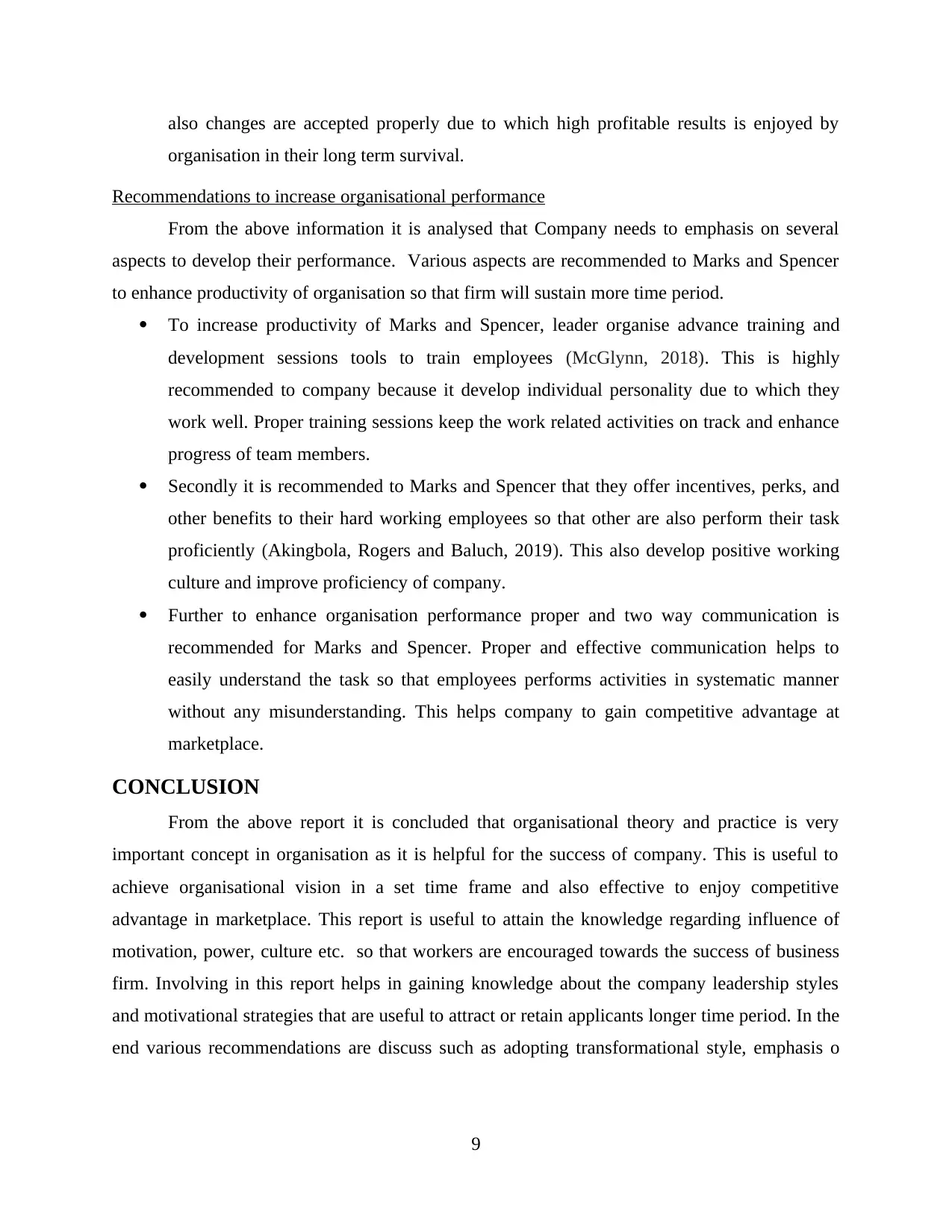
also changes are accepted properly due to which high profitable results is enjoyed by
organisation in their long term survival.
Recommendations to increase organisational performance
From the above information it is analysed that Company needs to emphasis on several
aspects to develop their performance. Various aspects are recommended to Marks and Spencer
to enhance productivity of organisation so that firm will sustain more time period.
To increase productivity of Marks and Spencer, leader organise advance training and
development sessions tools to train employees (McGlynn, 2018). This is highly
recommended to company because it develop individual personality due to which they
work well. Proper training sessions keep the work related activities on track and enhance
progress of team members.
Secondly it is recommended to Marks and Spencer that they offer incentives, perks, and
other benefits to their hard working employees so that other are also perform their task
proficiently (Akingbola, Rogers and Baluch, 2019). This also develop positive working
culture and improve proficiency of company.
Further to enhance organisation performance proper and two way communication is
recommended for Marks and Spencer. Proper and effective communication helps to
easily understand the task so that employees performs activities in systematic manner
without any misunderstanding. This helps company to gain competitive advantage at
marketplace.
CONCLUSION
From the above report it is concluded that organisational theory and practice is very
important concept in organisation as it is helpful for the success of company. This is useful to
achieve organisational vision in a set time frame and also effective to enjoy competitive
advantage in marketplace. This report is useful to attain the knowledge regarding influence of
motivation, power, culture etc. so that workers are encouraged towards the success of business
firm. Involving in this report helps in gaining knowledge about the company leadership styles
and motivational strategies that are useful to attract or retain applicants longer time period. In the
end various recommendations are discuss such as adopting transformational style, emphasis o
9
organisation in their long term survival.
Recommendations to increase organisational performance
From the above information it is analysed that Company needs to emphasis on several
aspects to develop their performance. Various aspects are recommended to Marks and Spencer
to enhance productivity of organisation so that firm will sustain more time period.
To increase productivity of Marks and Spencer, leader organise advance training and
development sessions tools to train employees (McGlynn, 2018). This is highly
recommended to company because it develop individual personality due to which they
work well. Proper training sessions keep the work related activities on track and enhance
progress of team members.
Secondly it is recommended to Marks and Spencer that they offer incentives, perks, and
other benefits to their hard working employees so that other are also perform their task
proficiently (Akingbola, Rogers and Baluch, 2019). This also develop positive working
culture and improve proficiency of company.
Further to enhance organisation performance proper and two way communication is
recommended for Marks and Spencer. Proper and effective communication helps to
easily understand the task so that employees performs activities in systematic manner
without any misunderstanding. This helps company to gain competitive advantage at
marketplace.
CONCLUSION
From the above report it is concluded that organisational theory and practice is very
important concept in organisation as it is helpful for the success of company. This is useful to
achieve organisational vision in a set time frame and also effective to enjoy competitive
advantage in marketplace. This report is useful to attain the knowledge regarding influence of
motivation, power, culture etc. so that workers are encouraged towards the success of business
firm. Involving in this report helps in gaining knowledge about the company leadership styles
and motivational strategies that are useful to attract or retain applicants longer time period. In the
end various recommendations are discuss such as adopting transformational style, emphasis o
9
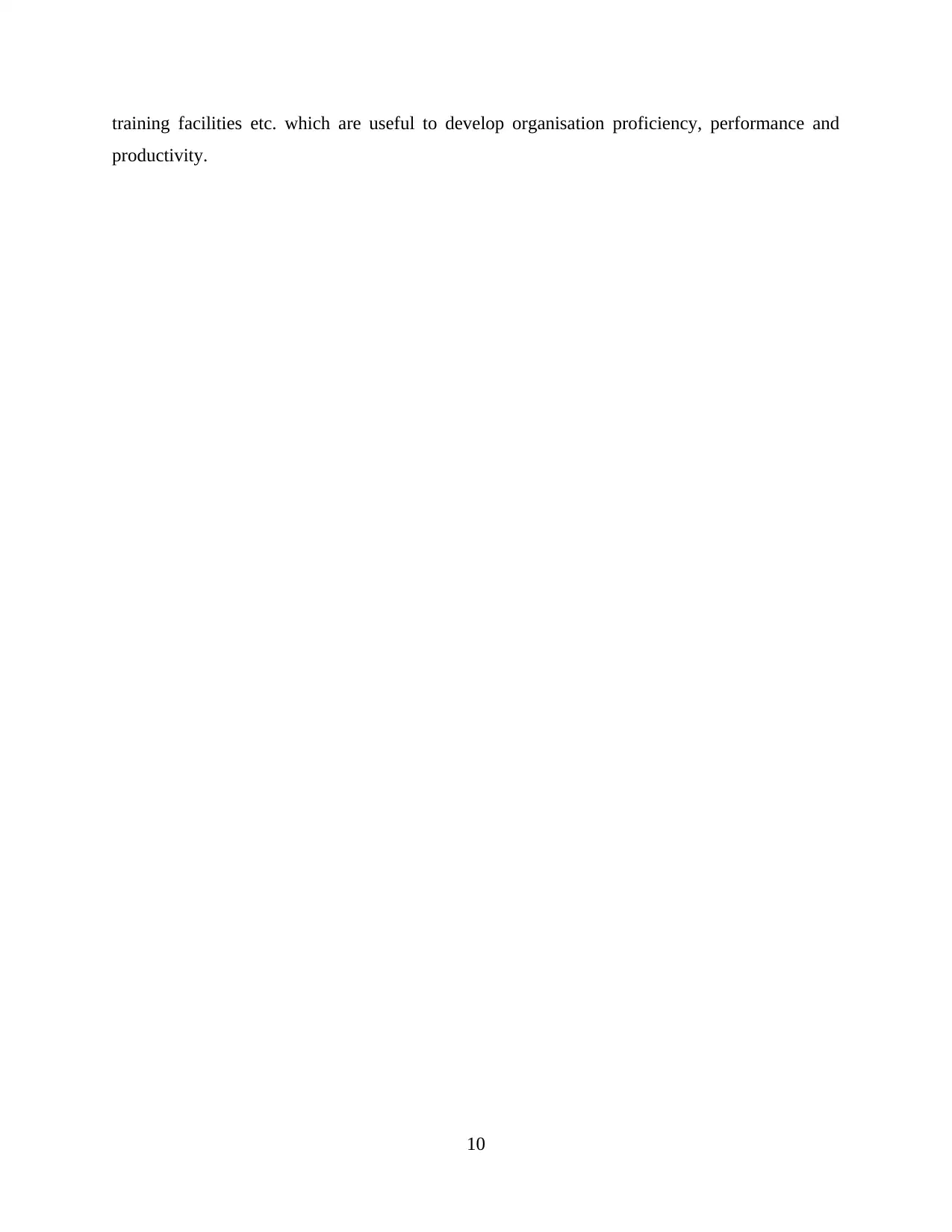
training facilities etc. which are useful to develop organisation proficiency, performance and
productivity.
10
productivity.
10
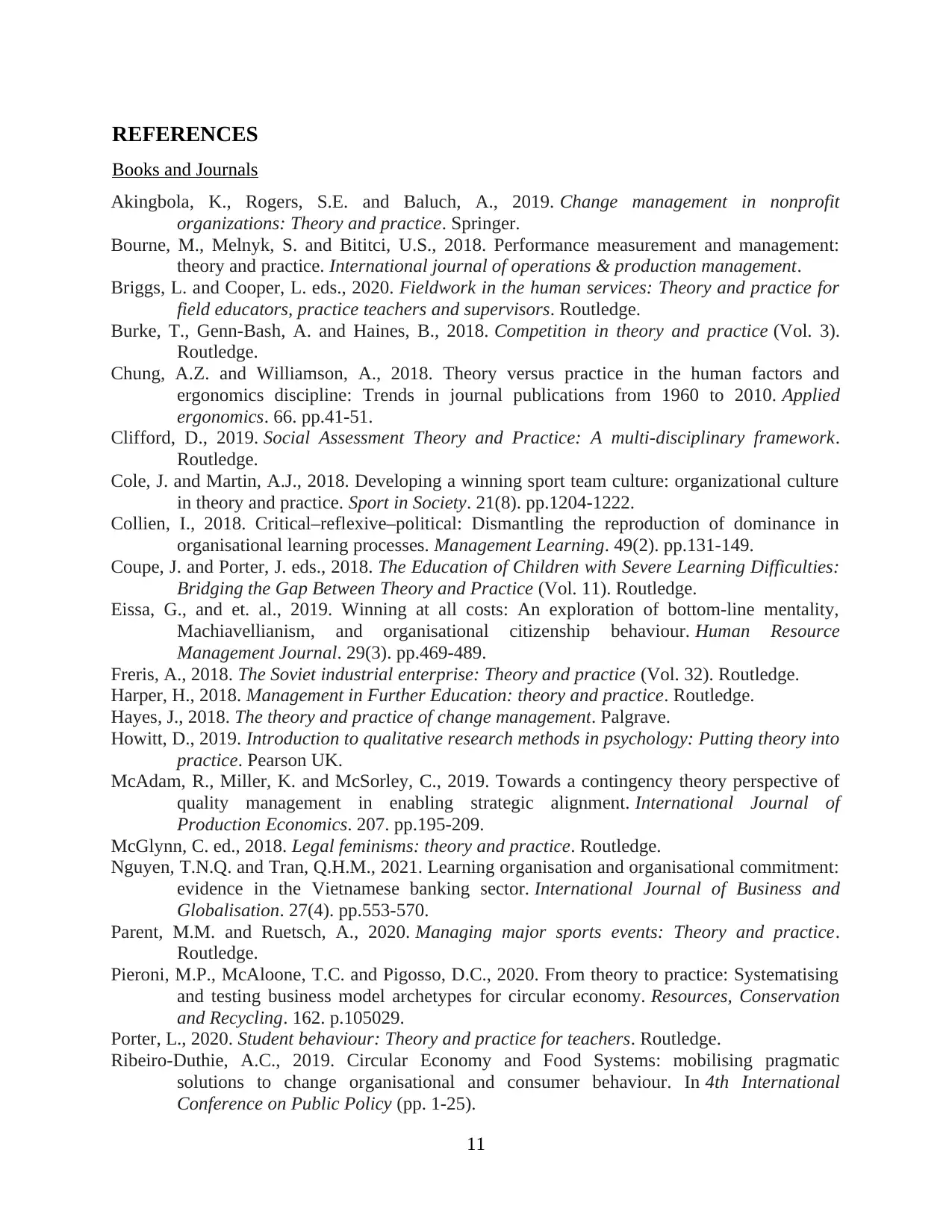
REFERENCES
Books and Journals
Akingbola, K., Rogers, S.E. and Baluch, A., 2019. Change management in nonprofit
organizations: Theory and practice. Springer.
Bourne, M., Melnyk, S. and Bititci, U.S., 2018. Performance measurement and management:
theory and practice. International journal of operations & production management.
Briggs, L. and Cooper, L. eds., 2020. Fieldwork in the human services: Theory and practice for
field educators, practice teachers and supervisors. Routledge.
Burke, T., Genn-Bash, A. and Haines, B., 2018. Competition in theory and practice (Vol. 3).
Routledge.
Chung, A.Z. and Williamson, A., 2018. Theory versus practice in the human factors and
ergonomics discipline: Trends in journal publications from 1960 to 2010. Applied
ergonomics. 66. pp.41-51.
Clifford, D., 2019. Social Assessment Theory and Practice: A multi-disciplinary framework.
Routledge.
Cole, J. and Martin, A.J., 2018. Developing a winning sport team culture: organizational culture
in theory and practice. Sport in Society. 21(8). pp.1204-1222.
Collien, I., 2018. Critical–reflexive–political: Dismantling the reproduction of dominance in
organisational learning processes. Management Learning. 49(2). pp.131-149.
Coupe, J. and Porter, J. eds., 2018. The Education of Children with Severe Learning Difficulties:
Bridging the Gap Between Theory and Practice (Vol. 11). Routledge.
Eissa, G., and et. al., 2019. Winning at all costs: An exploration of bottom‐line mentality,
Machiavellianism, and organisational citizenship behaviour. Human Resource
Management Journal. 29(3). pp.469-489.
Freris, A., 2018. The Soviet industrial enterprise: Theory and practice (Vol. 32). Routledge.
Harper, H., 2018. Management in Further Education: theory and practice. Routledge.
Hayes, J., 2018. The theory and practice of change management. Palgrave.
Howitt, D., 2019. Introduction to qualitative research methods in psychology: Putting theory into
practice. Pearson UK.
McAdam, R., Miller, K. and McSorley, C., 2019. Towards a contingency theory perspective of
quality management in enabling strategic alignment. International Journal of
Production Economics. 207. pp.195-209.
McGlynn, C. ed., 2018. Legal feminisms: theory and practice. Routledge.
Nguyen, T.N.Q. and Tran, Q.H.M., 2021. Learning organisation and organisational commitment:
evidence in the Vietnamese banking sector. International Journal of Business and
Globalisation. 27(4). pp.553-570.
Parent, M.M. and Ruetsch, A., 2020. Managing major sports events: Theory and practice.
Routledge.
Pieroni, M.P., McAloone, T.C. and Pigosso, D.C., 2020. From theory to practice: Systematising
and testing business model archetypes for circular economy. Resources, Conservation
and Recycling. 162. p.105029.
Porter, L., 2020. Student behaviour: Theory and practice for teachers. Routledge.
Ribeiro-Duthie, A.C., 2019. Circular Economy and Food Systems: mobilising pragmatic
solutions to change organisational and consumer behaviour. In 4th International
Conference on Public Policy (pp. 1-25).
11
Books and Journals
Akingbola, K., Rogers, S.E. and Baluch, A., 2019. Change management in nonprofit
organizations: Theory and practice. Springer.
Bourne, M., Melnyk, S. and Bititci, U.S., 2018. Performance measurement and management:
theory and practice. International journal of operations & production management.
Briggs, L. and Cooper, L. eds., 2020. Fieldwork in the human services: Theory and practice for
field educators, practice teachers and supervisors. Routledge.
Burke, T., Genn-Bash, A. and Haines, B., 2018. Competition in theory and practice (Vol. 3).
Routledge.
Chung, A.Z. and Williamson, A., 2018. Theory versus practice in the human factors and
ergonomics discipline: Trends in journal publications from 1960 to 2010. Applied
ergonomics. 66. pp.41-51.
Clifford, D., 2019. Social Assessment Theory and Practice: A multi-disciplinary framework.
Routledge.
Cole, J. and Martin, A.J., 2018. Developing a winning sport team culture: organizational culture
in theory and practice. Sport in Society. 21(8). pp.1204-1222.
Collien, I., 2018. Critical–reflexive–political: Dismantling the reproduction of dominance in
organisational learning processes. Management Learning. 49(2). pp.131-149.
Coupe, J. and Porter, J. eds., 2018. The Education of Children with Severe Learning Difficulties:
Bridging the Gap Between Theory and Practice (Vol. 11). Routledge.
Eissa, G., and et. al., 2019. Winning at all costs: An exploration of bottom‐line mentality,
Machiavellianism, and organisational citizenship behaviour. Human Resource
Management Journal. 29(3). pp.469-489.
Freris, A., 2018. The Soviet industrial enterprise: Theory and practice (Vol. 32). Routledge.
Harper, H., 2018. Management in Further Education: theory and practice. Routledge.
Hayes, J., 2018. The theory and practice of change management. Palgrave.
Howitt, D., 2019. Introduction to qualitative research methods in psychology: Putting theory into
practice. Pearson UK.
McAdam, R., Miller, K. and McSorley, C., 2019. Towards a contingency theory perspective of
quality management in enabling strategic alignment. International Journal of
Production Economics. 207. pp.195-209.
McGlynn, C. ed., 2018. Legal feminisms: theory and practice. Routledge.
Nguyen, T.N.Q. and Tran, Q.H.M., 2021. Learning organisation and organisational commitment:
evidence in the Vietnamese banking sector. International Journal of Business and
Globalisation. 27(4). pp.553-570.
Parent, M.M. and Ruetsch, A., 2020. Managing major sports events: Theory and practice.
Routledge.
Pieroni, M.P., McAloone, T.C. and Pigosso, D.C., 2020. From theory to practice: Systematising
and testing business model archetypes for circular economy. Resources, Conservation
and Recycling. 162. p.105029.
Porter, L., 2020. Student behaviour: Theory and practice for teachers. Routledge.
Ribeiro-Duthie, A.C., 2019. Circular Economy and Food Systems: mobilising pragmatic
solutions to change organisational and consumer behaviour. In 4th International
Conference on Public Policy (pp. 1-25).
11
Paraphrase This Document
Need a fresh take? Get an instant paraphrase of this document with our AI Paraphraser
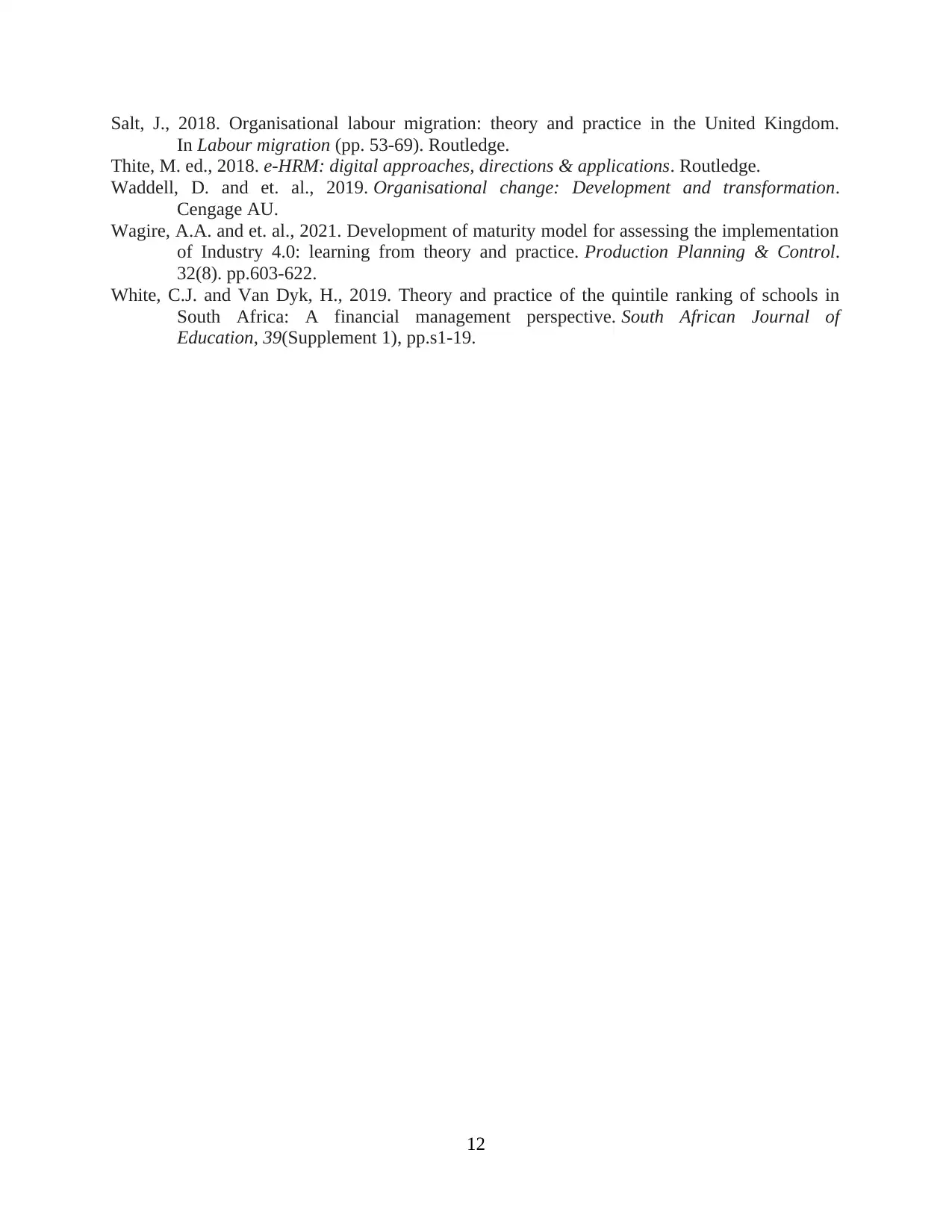
Salt, J., 2018. Organisational labour migration: theory and practice in the United Kingdom.
In Labour migration (pp. 53-69). Routledge.
Thite, M. ed., 2018. e-HRM: digital approaches, directions & applications. Routledge.
Waddell, D. and et. al., 2019. Organisational change: Development and transformation.
Cengage AU.
Wagire, A.A. and et. al., 2021. Development of maturity model for assessing the implementation
of Industry 4.0: learning from theory and practice. Production Planning & Control.
32(8). pp.603-622.
White, C.J. and Van Dyk, H., 2019. Theory and practice of the quintile ranking of schools in
South Africa: A financial management perspective. South African Journal of
Education, 39(Supplement 1), pp.s1-19.
12
In Labour migration (pp. 53-69). Routledge.
Thite, M. ed., 2018. e-HRM: digital approaches, directions & applications. Routledge.
Waddell, D. and et. al., 2019. Organisational change: Development and transformation.
Cengage AU.
Wagire, A.A. and et. al., 2021. Development of maturity model for assessing the implementation
of Industry 4.0: learning from theory and practice. Production Planning & Control.
32(8). pp.603-622.
White, C.J. and Van Dyk, H., 2019. Theory and practice of the quintile ranking of schools in
South Africa: A financial management perspective. South African Journal of
Education, 39(Supplement 1), pp.s1-19.
12
1 out of 14
Related Documents
Your All-in-One AI-Powered Toolkit for Academic Success.
+13062052269
info@desklib.com
Available 24*7 on WhatsApp / Email
![[object Object]](/_next/static/media/star-bottom.7253800d.svg)
Unlock your academic potential
© 2024 | Zucol Services PVT LTD | All rights reserved.




